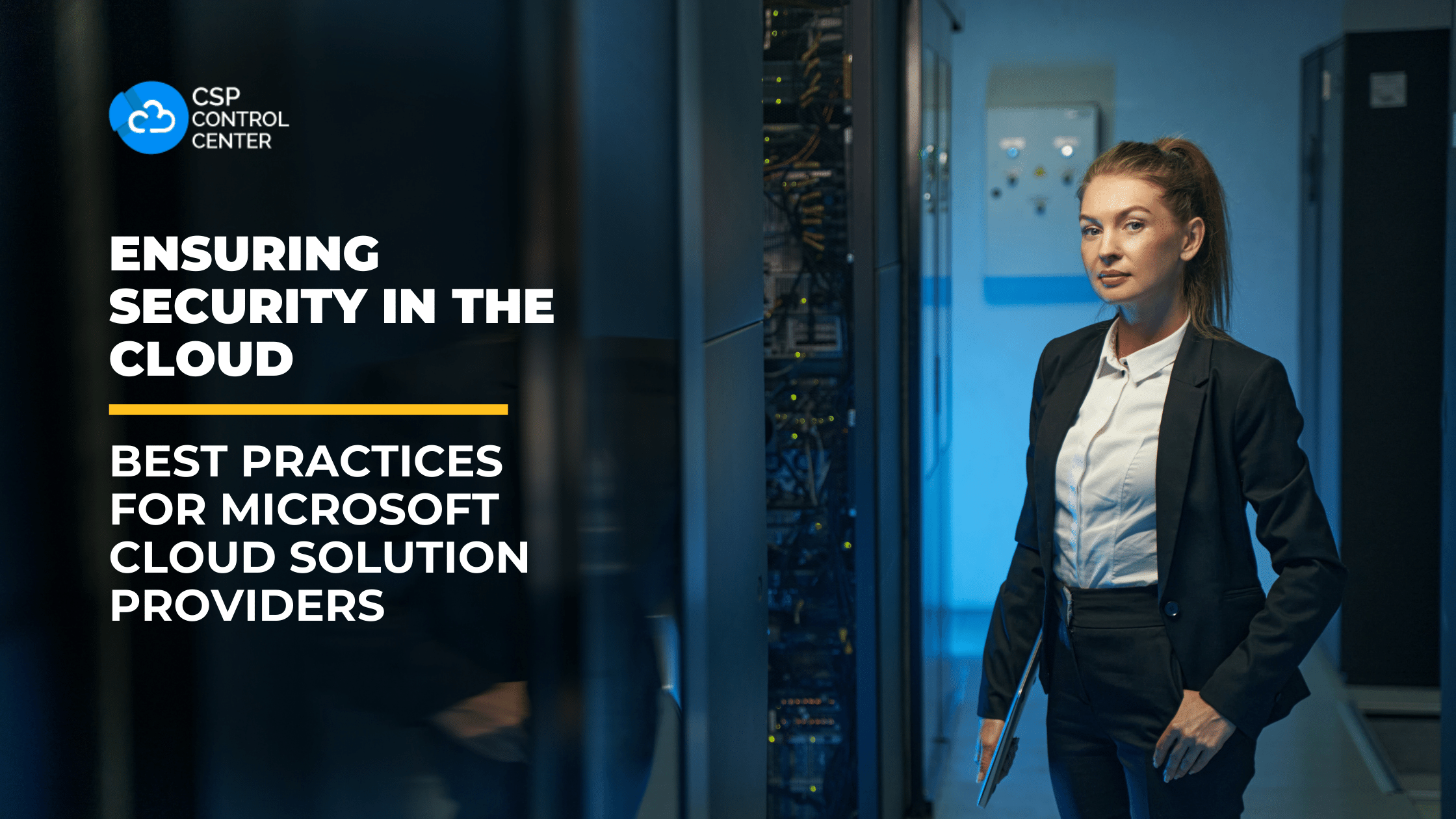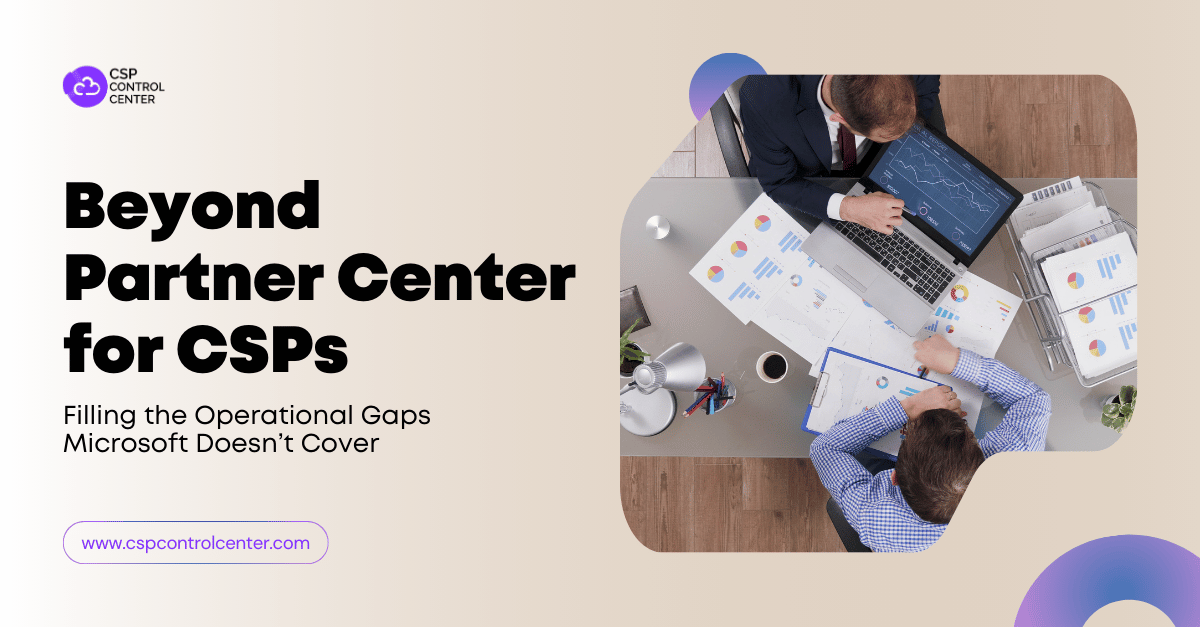Cloud computing has transformed how businesses operate in today’s digital era. Cloud computing offers businesses flexibility, scalability, and increased productivity. With cloud computing, businesses can tailor their resource allocation and storage capacity to meet ever-changing business needs without having to invest substantial amounts of money in physical infrastructure. They can easily scale up and down based on the requirements of the business. This helps us save costs as well as allowing them to respond quickly to market changes. Cloud computing can help businesses drive innovation, simplify processes, drive agility, and minimize workload. Businesses are increasingly recognizing the benefits of cloud computing, making it the backbone of many organizations. As the adoption of the cloud increases, the role of Microsoft CSP becomes more significant. As a Microsoft CSP, you not only need to provide services to your customers and ensure their smooth operations but also need to safeguard the cloud environment and protect sensitive data. The responsibility of securing the cloud environment is shared between Microsoft CSP and the customers. The level of accountability depends upon the different cloud service models. The different security responsibilities include:
- Data classification & accountability
- Client & end-point protection
- Identity & access management
- Application-level control
- Network control
- Host infrastructure
- Physical security
Some of these responsibilities require a collaborative effort between CSP and the customer.
Common Cloud Security Risks and Challenges
Despite the numerous benefits of cloud computing, there are several risks and challenges that must be addressed to ensure data confidentiality, data accessibility, and data integrity. As per Gartner, “By 2025, 45% of organizations worldwide will have experienced attacks on their software supply chains, a three-fold increase from 2021.” As a Microsoft CSP, you need to be aware of these risks and implement suitable measures to safeguard sensitive customer data. Some common cloud security risks and challenges are as follows:
Data Loss
Data loss can be a critical concern for businesses as its impact can be severe and far-reaching. Data loss can have financial implications as the business will have to bear additional expenses on data recovery and system restoration. Along with this, the operations can be disturbed leading to delays and loss of business. Losing critical business data limits the ability to make data-driven business decisions and maintain a competitive edge. There can be several factors that can lead to data loss such as human error which include deleting critical data or overwriting important files, misconfiguring cloud resources, etc. Another reason for data loss can be hardware failure due to malfunctioning or damage to servers, network devices, or storage devices. Data loss can also be due to natural disasters like earthquakes, floods, fires, etc.
Data Breaches
A data breach can be a significant risk for Microsoft CSPs. Any unauthorized access to confidential data affects various aspects of business operations. As a Microsoft CSP, you can incur additional expenses due to data breaches. These expenses can include regulatory fines, legal fees, investigation of unauthorized access, and implementing measures to safeguard your systems, etc.
Another impact of a data breach is loss of customer trust and damage to the business’s reputation. In case the customer data is stolen or compromised, the customers will lose trust in your ability to secure their data and will look for alternative service providers. This will increase customer churn and will negatively impact the image of your Microsoft CSP business. Negative publicity will make customer acquisition even more challenging and expensive. The damage of a data breach will not be limited to economic loss but can also have legal and regulatory consequences.
There can be many factors that can contribute to data breaches like weak passwords, lack of multi-factor authentication (MFA), failure to allocate role-based access controls (RBAC), stolen or compromised usernames or passwords, insecure APIs, inadequate monitoring, etc.
Cyberattacks
Cyberattacks can have far-reaching impacts on your Microsoft CSP business. These attacks can lead to business disruptions and downtime, financial losses, and non-compliance with data protection regulations, such as General Data Protection Regulation (GDPR) or any other country or industry-specific guidelines and regulations.
Attackers can use various techniques to target your business. These cybercriminals can use phishing emails, deceptive websites, pretexting, and other social engineering techniques to trick your employees or your customers into sharing sensitive information. Using stolen account credentials, guessing weak passwords, or using brute force attacks can be ways by which hackers can try to gain access to your cloud environment. These attackers can also infect your systems with malicious software such as viruses, trojans, worms, spyware, ransomware, etc.
Insider Threats
Insiders can be people like your employees who possess authorized access to your systems and sensitive data. Similar to other threats that have been discussed above, insider threats also lead to financial harm, legal consequences, reputational damage, disrupt day-to-day business operations, etc. Insider threats can be both intentional and non-intentional. Some malicious employees can misuse their access privileges to harm your business or for any other personal gain. These individuals can intentionally damage the systems, disrupt operations, disclose, or steal confidential information, commit fraud, or do any other activities with the aim of sabotaging your Microsoft CSP business.
Another form of insider threat could be due to the negligence of employees. The employees might unintentionally leak sensitive information or expose your systems to vulnerabilities. This could be due to failure to follow security practices or human errors such as mishandling of sensitive data.
Best Security Practices for Microsoft CSPs
Ensuring the privacy and security of your as well as your customers’ data is of utmost importance. According to Microsoft, “Prevention is truly the best defense, and we’re only as strong as our weakest link.” To help CSPs protect their customers and tenants, Microsoft introduced the mandatory security requirements that you need to follow to transact in the Microsoft CSP program. You can access these mandatory security requirements by logging into the Partner Centre. Implementing robust security practices is crucial in safeguarding against cyber threats, fulfilling regulatory obligations, and preserving customer confidence.
Enable multi-factor authentication (MFA)
Multi-Factor Authentication (MFA) adds an additional layer of security to user accounts. It is essential to have MFA enabled for all users across partner tenants when accessing Microsoft commercial cloud services or engaging in CSP transactions via the Partner Center portal or APIs. To enforce MFA, you can use Microsoft Azure Active Directory (Azure AD) security defaults or Conditional Access. By adding additional verification measures such as using one-time verification codes, logging from trusted devices, etc, the risk of unauthorized access to sensitive data and resources is reduced.
Adopt the Secure Application Model
As a Microsoft CSP, you need to adopt the Secure Application Model Framework when you integrate your applications with Partner Center APIs. Security attacks on marketplace applications can compromise customer data. By following the secure application model guidelines and best practices, such as strong authentication protocols, allowing access based on the principle of least privilege, restricting access to a specific audience or API, timebound access permissions, etc. you can ensure that the Partner Centre ecosystem is protected.
Educate and Train Your Employees
Conducting training and awareness programs on security threats and best practices is important in maintaining a secure environment. Training can help employees understand the risks they can be exposed to. Your employees will be able to handle sensitive information, identify suspicious activities such as phishing attacks, and will be well-equipped to handle security threats effectively. By learning about security protocols and policies, the employees become more vigilant, which will improve the overall security posture of your business.
Migrate to the Granular delegated Admin Privileges (GDAP) model
To access and manage your customers’ subscriptions your customers need to grant administrative permissions. These permissions were granted under the Delegated Administration Privileges (DAP) model wherein the customer had to accept the reseller relationship invitation from a CSP after which the CSP could manage the customer’s account on their behalf. DAP had some security concerns related to broad privileges and access to the customer account. To address these concerns as well as implement a zero-trust security model, Microsoft has introduced a new model, Granular delegated Admin Privileges (GDAP). GDAP offers several security features that are beneficial for both your customers as well as you. Some of the advantages of GDAP over DAP are custom access, more control, defined relationship duration, better compliance, etc. To learn more about GDAP and plan the DAP to GDAP transition, you can read our blog, “Managing the transition from DAP to GDAP as a Microsoft CSP”
Actively Monitor Azure Fraud Notifications
As a Microsoft CSP, it is important to closely monitor Azure fraud notifications. By doing so you will be able to identify and respond to potential security threats to your customers’ Azure subscriptions. If Microsoft detects any suspicious activity in a customer’s Azure subscription, it will send a fraud notification to you. A type of fraud that could occur could be the mining of cryptocurrency using a customer’s Azure resources. After receiving the alerts, you need to determine whether fraudulent activity is occurring or not. If the Azure subscription is compromised, then you need to immediate action to prevent further business risk. More information on monitoring and responding to Azure fraud notifications is available here.
Partner with C3 and safeguard your cloud environment
Ensuring the security of customer data is essential for sustaining a Microsoft CSP business. But keeping the sensitive data safe is no easy task. You need to invest time and resources to keep your cloud environment secure. You need to protect your systems from hacking attempts, train your employees in cyber security, and assess and manage third-party or vendor risks. Managing business operations along with these tasks can be quite challenging. As your business grows your employees might find it difficult to divide their time between carrying out the day-to-day business activities and safeguarding sensitive data.
Using a Microsoft CSP billing automation tool such as C3 will help your team members manage billing, reconciliation, payment collection, provisioning, etc with ease. With automation, your team members will no longer have to spend long hours manually managing customer subscriptions. This will lower employee fatigue and reduce instances of human error. With more time on their hands, your employees will be able to focus better on improving the security of your systems. C3 is a GDPR, SOC2 Type II, and PCI compliant CSP billing automation platform which ensures that the data of your customers is handled responsibly and securely.
C3 offers a host of features that can help you streamline your Microsoft CSP business. To know more, book a demo.

 CSP Control Center
CSP Control Center
 CloudEvents
CloudEvents


